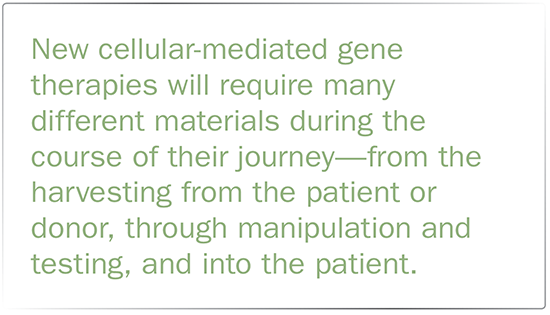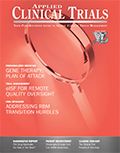The Gene Therapy Product Development Process
Applied Clinical Trials
Navigating the many complexities in clinical trials, manufacturing, and regulatory interaction in moving gene therapies from development to market.

While the field of gene transfer has been active and evolving over the past 30 years, there are only a handful of products that have recently become approved gene therapies. Most product developers believe that gene transfer is now at a tipping point, but realize it will require a close coupling between the accumulating scientific knowledge and the therapeutic target product development expertise to generate approved gene therapies at an increasingly rapid rate. Although it is an inaccurate term (nothing is a therapy until it has market approval), gene therapy has become a ubiquitous term to refer to gene transfer products and the more recently discovered gene editing (e.g., CRISPR) products in development.
Gene transfer products are meant to treat diseases resulting from lack of a gene’s functional protein product. The gene addition can be accomplished either by in vivo (vectors and other delivery vehicles) or ex vivo (manipulation of a patient’s own cells and reinfusion) techniques. Both in vivo and ex vivo gene addition techniques are currently at the forefront of science, which explains the paucity of marketing applications that have been submitted, let alone approved, in recent years. Gene editing products in development are meant to alter the existing gene, thereby conferring efficacy and not add a new functional copy of the gene; but none of these have been approved as of yet.
Keeping up with the science
Over the last several years, gene therapy technologies and products have primarily been developed by biotechnology companies, academic laboratories, and government laboratories as large pharmaceutical firms have evolved to marketing and sales companies by divesting themselves of a great number of research scientists and licensing in these technologies from other entities. However, few academic or government organizations are experienced with the entire product development process, including bringing a product to market. Therefore, there must be a coordinated effort and close collaboration between academia/government and biotech development talent to access both scientific and product development knowledge required for a program to be successful.
Updated FDA guidances provide clarity and require more information
While gene therapy products provide potential for exciting breakthroughs, they are also extremely complex to develop for the market. This complexity has prompted the FDA to recently release additional guidances to help move these products forward. Early FDA gene therapy guidances include traditional investigational new drug (IND) requirements and Phase I good manufacturing practice (GMP) guidance. Two of the six 2018 gene therapy guidances are related to requirements for long-term follow-up monitoring and other clinical study design considerations, as well as chemistry and manufacturing and controls (CMC) procedures and practices to ensure safety. This is not surprising inasmuch as regulators have been concerned about the safety of gene therapy products from the inception of this field due to the lack of complete understanding of the science surrounding these products.

Considering there is no track record for the administration of these products, companies should be aware of these guidances and budget for extensive follow-up (e.g., five years) for their clinical study subjects and potentially even the patients treated with their product after it is approved to determine the eventual safety profile and durability of the therapeutic effect. As far as manufacturing concerns go, new cellular-mediated gene therapy products will require many different materials during the course of their journey-from the harvesting from the patient or donor, through manipulation and testing, and into the patient. Hence, a comprehensive list of the materials used in the process and a description of their quality and suitability must be included in the regulatory submissions.
An accelerated clinical plan
Since most gene therapy products are targeted for life-threatening or serious orphan diseases with unmet medical needs, the clinical plan will, in all likelihood, be expedited relative to the traditional clinical plan for a product intended to treat more conventional diseases. This acceleration requires early and more frequent interaction with regulatory authorities to ensure agreement on such things as 1.) novel clinical endpoints that convincingly demonstrate clinical benefit; 2.) biomarkers or other endpoints that could potentially be used as surrogate clinical endpoints; 3.) collection of data reflecting the natural history of the disease from the literature, real-world evidence, or via the conduct of a de novo natural history clinical study; and 4.) patient-reported outcomes focusing on quality of life metrics that matter to the patients or their caregivers, all of which can contribute to the totality of the data regulators will integrate to ultimately reach their decision on marketing approval.
A comprehensive CMC plan
One of the main takeaways from the updated FDA guidance is the need for a strategic CMC development plan, because if the product cannot be manufactured safely, then clinical studies will inevitably be delayed. For gene therapy products, CMC work often ends up being a rate limiting step in preparing for the initial IND as well as the eventual marketing application submission of a gene therapy product.
A comprehensive CMC plan is also important because the FDA places a greater emphasis on the quality portion of the submission for gene therapy products than for traditional therapies. In a 2018 interview with former FDA Commissioner Scott Gottlieb, he stated, “that for most standard drugs, traditionally 80% of the review process is focused on clinical aspects and only 20% on quality or is CMC related. For gene therapy products, those numbers are reversed.” From this, sponsors and CROs can be sure that the CMC modules in their submission must be comprehensive to obtain regulatory approval.
Consider an INTERACT/pre-pre-IND meeting
Some products need to be discussed early with the FDA so that sponsors have buy-in from FDA on their proposed development plans. If eligible, sponsors should take the opportunity to sit down with the FDA in an INTERACT meeting (aka, Initial Targeted Engagement for Regulatory Advice on CBER products; previously known colloquially as a pre-pre-IND meeting). This interaction is used to educate the FDA about the sponsor’s product and familiarize the agency with the science behind it and help FDA understand the rationale behind their integrated product development plan. These meetings also can be crucial in helping obtain agreement for the preclinical program. Additionally, sponsors should use the INTERACT meeting to get clarification on CMC aspects related to specifications, controls, as well as what steps they want to see in terms of the manufacturing process.
The path forward
In summary, the only way to move some of these gene-based products forward quickly is with more FDA interaction than is usually recommended for developing products. The guidances issued thus far are not sufficient to enable a company to make much development progress without interacting with the FDA. By asking the correct questions at regulatory meetings and listening carefully so product sponsors may coalesce bits and pieces of information, the FDA has learned from other gene therapy sponsors that have submitted INDs and bioligics license applications (BLAs) for gene therapy products. The FDA is unable to breach confidentiality with product sponsors, but they will comment much more intelligently as a result of its experience with many of these products.
When one looks at the remarkable efficacy that some gene therapy products are providing, it also makes sense for the agency to prioritize and expedite gene therapy guidances and help sponsors develop treatments that can make a difference. However, if a company’s development team comprises individuals who both understand the science supporting these novel products and are experienced with the guidances and regulatory precedents established for previous product approvals in these or similar indications, a gene therapy program may ultimately make it to market.
David Shoemaker, PhD, is Senior Vice President, R&D, Rho Inc.

Driving Diversity with the Integrated Research Model
October 16th 2024Ashley Moultrie, CCRP, senior director, DEI & community engagement, Javara discusses current trends and challenges with achieving greater diversity in clinical trials, how integrated research organizations are bringing care directly to patients, and more.
Rybrevant Plus Lazcluze Shows Over One-Year Survival Boost in EGFR-Mutated NSCLC Patients
January 7th 2025Results from the Phase III MARIPOSA trial demonstrated the combination of Rybrevant (amivantamab-vmjw) and Lazcluze (lazertinib) significantly improves overall survival compared to the current standard of care, Tagrisso (osimertinib), for patients with EGFR-mutated advanced or metastatic non-small cell lung cancer.